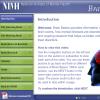Search

Mind Your Mouth
If you have it, you’re not alone. Many adults nationwide have some form of gum disease. It can simply cause swollen gums or give you bad breath. It can also ruin your smile or even make you lose your teeth. The good news is that gum disease can be prevented with daily dental care. The problem begins with bacteria. Our mouths are packed with these tiny microbes. They combine with mucus and other…

Fun Summer Days
School’s out. Things are slow at work. And the warmer weather brings lots of new opportunities to improve your health: plenty of fresh, local produce and more choices for outside activities. Here’s how to make the most of the summer months. “When the weather is nice, there are more opportunities for getting outdoors and having fun with your family and incorporating exercise into day-to-day life…, Slip on protective clothing., Choose shirts with long sleeves and long pants to protect as much as your body from the sun as possible. Many modern fabrics are light and breathable yet protect your skin from the sun. “A good rule is if you can see through the clothing, UV can pass through it and it will not provide you optimum protection,” Perna says. Some clothes are now marked with an “Ultraviolet Protection Factor” or “UPF…, Slop on sunscreen., It may help prevent skin cancer, although sunscreen can’t replace avoiding the sun during peak hours, staying in the shade and wearing protective clothing. Look for sunscreen with a sun protection factor (SPF) of at least 15. Those with an SPF of 30 or higher will provide the most protection. Right now, unfortunately, SPF only measures protection from UVB rays. “Since both UVA and UVB cause…, Slap on a hat., “All hats are not equally protective,” Hartman notes. “Choose hats that are broad brimmed all around to shade the ears and neck as well as the face.” And finally,, wrap on sunglasses., The label should say that the lenses block at least 99% of UVA and UVB radiation. Now that you’ve got yourself covered, you can get outside and get active. Don’t forget there are also healthy eating opportunities that come with warmer weather. “I think it’s easier to eat healthfully during the summer,” Yanovski says. “When you’re hot, a salad tastes really good. It’s easy to grill some chicken…

It’s a Noisy Planet. Protect Their Hearing.
Kids and teens are often exposed to noise levels that could permanently harm their hearing over time. Learn about the causes of noise-induced hearing loss and how to prevent it, so your kids—and you—can have healthy hearing for life. Noisy Planet recently launched a Spanish-language version of the website too.

The Salty Stuff
Salt is essential to our body’s fluids. That’s likely why we evolved to enjoy its taste. On the other hand, anyone who’s gotten a mouth full of seawater knows that too much salt tastes terrible. Maybe your body’s trying to tell you something. It turns out that too much salt can lead to a host of health problems. The chemical name for dietary salt, or table salt, is sodium chloride. Since 90% of…

Things Forgotten
Chances are you’ve walked into a room and forgotten why you went there. And misplaced your keys or eyeglasses at least a few times. Many people worry about these memory lapses. They fear they’re heading toward a serious condition like Alzheimer’s disease, an irreversible brain illness. Occasional forgetfulness is a normal part of life that becomes more common as we grow older. In most cases, it’s…

Summer Swimtime
Summer is a great time to go out and have fun in the water. But recreational waters—including swimming pools, lakes and oceans—can sometimes get contaminated with bacteria and viruses. Swimming in contaminated water can make you and your family sick. The most common illnesses caused by contaminated water are stomach and intestinal upsets, usually with vomiting or diarrhea. You can pick up these…, Vibrio, species, are especially dangerous for people with certain medical conditions, such as diabetes or liver disease. “If you have a compromised immune system and you get a, Vibrio, infection, those are going to be very serious,” Noble says. The infections might even be deadly. If you have a medical condition that affects your immune system, talk to your doctor before heading for the water. Our shared oceans and lakes are great for fun and relaxation. But our habits on land affect the quality of these precious resources. “Doing small things, like picking up after your dog…

Don’t Toss the Floss!
You may have seen or heard news stories suggesting that you can forget about flossing, since scientists lack solid evidence that you’ll benefit from cleaning between your teeth with a sturdy string. But many dentists may beg to differ. They’ve seen the teeth and gums of people who floss regularly and those who haven’t. The differences can be striking. “Every dentist in the country can look in…

Brain Basics
Simple and straight-forward videos give you the basics of brain biology. Get an overview of how the brain works and how mental illness is linked to brain function. Learn about brain regions, neurotransmitters, gene studies, brain imaging and more.*, *Editor's Note:, This website has been archived and is no longer available.

Halt the Hurt!
Pain—it’s something we’ve all experienced. From our first skinned knee to the headaches, back pain and creaky joints as we age, pain is something we encounter many times. Most pain is acute and goes away quickly. But in some cases, when pain develops slowly or persists for months or even years, then it’s called chronic pain, and it can be tricky to treat. Chronic pain is a huge problem. Over 115…

Mindfulness Matters
At some point in your life, someone probably told you: “Enjoy every moment. Life is short.” Maybe you’ve smiled and rolled your eyes at this well-intentioned relative or co-worker. But the fact is, there’s something to it. Trying to enjoy each moment may actually be good for your health. The idea is called mindfulness. This ancient practice is about being completely aware of what’s happening in…
NIH Office of Communications and Public Liaison
Health and Science Publications Branch
Building 31, Room 5B52
Bethesda, MD 20892-2094
Contact Us:
nihnewsinhealth@od.nih.gov
Phone: 301-451-8224
Share Our Materials: Reprint our articles and illustrations in your own publication. Our material is not copyrighted. Please acknowledge NIH News in Health as the source and send us a copy.
For more consumer health news and information, visit health.nih.gov.
For wellness toolkits, visit www.nih.gov/wellnesstoolkits.
